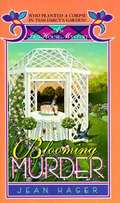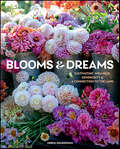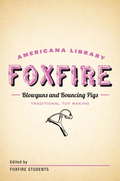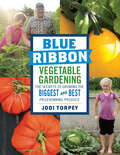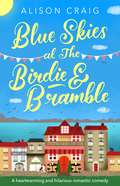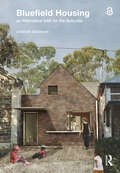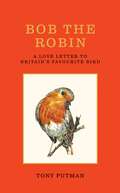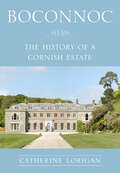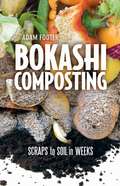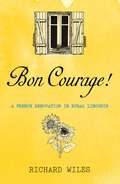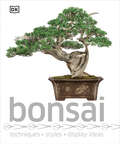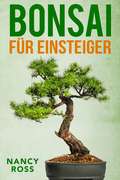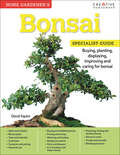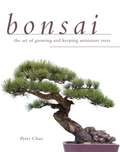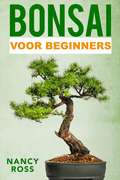- Table View
- List View
Blooming Murder (Iris House Mystery Ser. #1)
by Jean Hager"A timely inheritance has enabled spunky, self-sufficient Tess Darcy to transform her late Aunt Iris's estate into a charming bed-and-breakfast inn. Aptly enough, among her first guests is a gaggle of gardening enthusiasts gathered together for the regional Iris Growers' Convention--a thorny bunch more interested in digging up dirt than in weeding and watering. And when one of them turns up dead in Tess's magnificent garden--a cake knife planted firmly in her chest--it falls to the harried hostess to unearth the killer... before any more corpses spring up." The complete seven novel Iris House cozy mystery series is in the Bookshare Collection. Most have several recipes at the end, after the core text. Look for: #2. Dead and Buried, #3. Death on the Drunkard's Path, #4. The Last Noel, #5. Sew Deadly, #6. Weigh Dead and #7. Bride and Doom.b
Blooms & Dreams: Cultivating Wellness, Generosity & a Connection to the Land
by Misha GillinghamMisha Gillingham is a travel writer turned farm girl whose story has won over the hearts of fans worldwide. In Blooms & Dreams, Misha shares not only what brought her to Evergreen Acres, a farm on Bainbridge Island in the Pacific Northwest, but also all of the wisdom she has gleaned over the years as she and her family put down roots. While leading readers on a behind-the-scenes tour of the farm—from her ever-evolving flower garden to the menagerie of animals who keep everyone in good spirits—Misha reflects on her own transformation and shares how joy can be found by contributing to your local community and fostering a deep connection to the land itself. Blooms & Dreams will inspire readers from all walks of life to consider building a life centered around wellness, giving, and a connection to the land, be it a small patio garden or an entire farm.
Blowguns and Bouncing Pigs: The Foxfire Americana Library (6) (The Foxfire Americana Library)
by Inc. Foxfire FundThe Foxfire Americana Library takes you back to the good ol' days with a collection of simple, classic toys that can be made at home. Complete with illustrated step-by-step instructions, "Blowguns and Bouncing Pigs" includes advice on how to make: Ball and CupsBlowgunsBouncing PigsBows and ArrowsBubble BlowersBull GrindersButtons on a StringClimbing BearsCorn GunsCornstalk AnimalsCornstalk FiddleApple-head DollsCucumber DollsFluttermillsFly GunsHoopsJumping JacksKicking MulesLimberjacksPop GunsPuzzlesRattletrapsRolling ClownsSling ShotsSmoke GrindersSquirt GunsStick HorsesStiltsGrapevine SwingsRope SwingsTops or DancersWhimmy Diddles or Jeep SticksHollow WhistlesSplit WhistlesWhittled Animals
Blue & White Japan
by Yutaka Satoh Amy Slyvester KatohThis delightful book shows that wherever it is used, the creative juxtaposition of blue and white provides both visual nourishment and spiritual balm. From the ephemeral beauty of a wind-blown noren curtain to the powerful geometry of zabuton cushions, to the calming symmetry of a soba cup - whether new or old, homely or sophisticated - all of these objects convey a lyrical message that speaks to our senses, inspiring us to seek out new ways to collect, create, and live with Japanese blue & white
Blue Ribbon Vegetable Gardening: The Secrets to Growing the Biggest and Best Prizewinning Produce
by Jodi TorpeyWin the blue ribbon every time! Master Gardener Jodi Torpey offers all the information you need to grow champion vegetables — beans, beets, cabbages, cucumbers, eggplants, onions, peppers, pumpkins, squash, and tomatoes — covering everything from choosing the right varieties and scheduling planting dates to harvesting, preparing, and transporting your produce. She also walks you through every aspect of competitive showing, with useful tips for thinking like a judge. This book will delight you with lively photos of mammoth pumpkins, truly gigantic onions, perfectly pear-shaped eggplants, and the farmers and gardeners who grow them. Filled with the excitement of a county fair, it’s a fun read as well as a solid guide to growing the biggest, tastiest, best-looking vegetables for miles around.
Blue Skies at The Birdie and Bramble (The Birdie & Bramble series #3)
by Alison CraigAs the sun starts to shine it's time for Maddy and the team at The Birdie & Bramble to make some changes, but will Maddy find the strength to stand up for what she wants and discover the true nature of friends, family and love? Readers are loving Blue Skies at the Birdie and Bramble! 'An easy read, perfect for a summer holiday break and is sure to put a smile on your face' 'This book is wonderful and I loved it' 'A good, feel-good story about a supportive clique of friends and significant others who work together to make their little corner of Scotland a colorful, tasty and friendly place' 'Thoroughly enjoyed the life at the birdie and bramble, felt like I was one of their friends, loved the characters and of course Maddy, loved the description of st Andrews and the village where the birdie and bramble is located'
Blue Skies at The Birdie and Bramble: A hilarious and feel-good Scottish romance (The Birdie & Bramble series #3)
by Alison CraigAs the sun starts to shine it's time for Maddy and the team at The Birdie & Bramble to make some changes, but will Maddy find the strength to stand up for what she wants and discover the true nature of friends, family and love? Readers are loving Blue Skies at the Birdie and Bramble! 'An easy read, perfect for a summer holiday break and is sure to put a smile on your face' 'This book is wonderful and I loved it' 'A good, feel-good story about a supportive clique of friends and significant others who work together to make their little corner of Scotland a colorful, tasty and friendly place' 'Thoroughly enjoyed the life at the birdie and bramble, felt like I was one of their friends, loved the characters and of course Maddy, loved the description of st Andrews and the village where the birdie and bramble is located'
Bluefield Housing as Alternative Infill for the Suburbs
by Damian MadiganSuburbanised cities share a common dilemma: how to transition to more densely populated and socially connected urban systems while retaining low-rise character, avoiding gentrification, and opening neighbourhoods to more diverse housing choices. Bluefield Housing offers a new land definition and co-located infill model addressing these concerns, through describing and deploying the types of ad-hoc modifications that have been undertaken in the suburbs for decades. Extending green-, brown-, and greyfield definitions, it provides a necessary middle ground between the ‘do nothing’ attitude of suburban preservation and the ‘do everything’ approach of knock-down-rebuild regeneration. An adjunct to ‘missing middle’ and subdivision densification models, with a focus on co-locating homes on small lots, Bluefield Housing presents a unified design approach to suburban infill: retrofitting original houses, retaining and enhancing landscape and urban tree canopies, and delivering additional homes as low-rise additions and backyard homes suited to the increasingly complex make-up of our households. Extensively illustrated by the author with engaging architectural design studies, Damian Madigan describes how existing quirks of suburban housing can prompt new forms of infill, explains why a new suburban densification model is not only necessary but can be made desirable for varied stakeholders, and charts a path towards the types of statutory and market triggers required to make bluefield housing achievable. Using Australian housing as an example but addressing universal concerns around neighbourhood character, demographic needs, housing diversity, dwelling flexibility, and landscape amenity, Bluefield Housing offers innovative suburban infill ideas for policy makers, planners, architects, researchers and students of housing and design studies, and for those with a stake in the future of the suburbs.
Bluefield Housing as Alternative Infill for the Suburbs
by Damian MadiganSuburbanised cities share a common dilemma: how to transition to more densely populated and socially connected urban systems while retaining low-rise character, avoiding gentrification, and opening neighbourhoods to more diverse housing choices. Bluefield Housing offers a new land definition and co-located infill model addressing these concerns, through describing and deploying the types of ad-hoc modifications that have been undertaken in the suburbs for decades. Extending green-, brown-, and greyfield definitions, it provides a necessary middle ground between the ‘do nothing’ attitude of suburban preservation and the ‘do everything’ approach of knock-down-rebuild regeneration.An adjunct to ‘missing middle’ and subdivision densification models, with a focus on co-locating homes on small lots, Bluefield Housing presents a unified design approach to suburban infill: retrofitting original houses, retaining and enhancing landscape and urban tree canopies, and delivering additional homes as low-rise additions and backyard homes suited to the increasingly complex make-up of our households.Extensively illustrated by the author with engaging architectural design studies, Damian Madigan describes how existing quirks of suburban housing can prompt new forms of infill, explains why a new suburban densification model is not only necessary but can be made desirable for varied stakeholders, and charts a path towards the types of statutory and market triggers required to make bluefield housing achievable. Using Australian housing as an example but addressing universal concerns around neighbourhood character, demographic needs, housing diversity, dwelling flexibility, and landscape amenity, Bluefield Housing offers innovative suburban infill ideas for policy makers, planners, architects, researchers and students of housing and design studies, and for those with a stake in the future of the suburbs.The Open Access version of this book, available at www.taylorfrancis.com, has been made available under a Creative Commons Attribution-Non Commercial-No Derivatives (CC-BY-NC-ND) 4.0 license.
Blueprint for Greening Affordable Housing, Revised Edition
by Walker Wells Kimberly VermeerBlueprint for Greening Affordable Housing is the most comprehensive resource on how green building principles can be incorporated into affordable housing design, construction, and operation. In this fully revised edition, Walker Wells and Kimberly Vermeer capture the rapid evolution of green building practices and make a compelling case for integrating green building in affordable housing. The Blueprint offers guidance on innovative practices, green building certifications for affordable housing, and the latest financing strategies. The completely new case studies share detailed insights on how the many elements of a green building are incorporated into different housing types and locations. Every affordable housing project can achieve the fundamentals of good green building design. The Blueprint gives project teams what they need to push for excellence.
Bob the Robin: A love letter to Britain’s favourite bird
by Tony Putman'When a robin appears, a loved one is near' In 2019, Tony Putman was working as a gardener in Edenbridge, Kent, when he noticed a bold robin sitting on a branch of an old plum tree. The robin glanced in his direction as he approached, but he didn't move, so Tony grabbed his camera and took a photo. This would be the first of hundreds of photos that Tony would take of Bob the robin - and the start of an extraordinary friendship that would last for years.As Tony shared his pictures on his social media account, Putman and Robin, he witnessed an outpouring of love - not just for Bob, but for robins everywhere, who populate our gardens with song and movement even on the direst winter days.In this book, Tony shares his touching journey with Bob, and tells the story of our unwavering affection for these magnificent creatures. This is an informative book about the life of a robin, as well as a beautiful love letter to these spirited and lively birds - who offer us a connection with nature, a moment of contact and a great source of comfort and joy.
Bob the Robin: A love letter to Britain’s favourite bird
by Tony Putman'When a robin appears, a loved one is near' In 2019, Tony Putman was working as a gardener in Edenbridge, Kent, when he noticed a bold robin sitting on a branch of an old plum tree. The robin glanced in his direction as he approached, but he didn't move, so Tony grabbed his camera and took a photo. This would be the first of hundreds of photos that Tony would take of Bob the robin - and the start of an extraordinary friendship that would last for years.As Tony shared his pictures on his social media account, Putman and Robin, he witnessed an outpouring of love - not just for Bob, but for robins everywhere, who populate our gardens with song and movement even on the direst winter days.In this book, Tony shares his touching journey with Bob, and tells the story of our unwavering affection for these magnificent creatures. This is an informative book about the life of a robin, as well as a beautiful love letter to these spirited and lively birds - who offer us a connection with nature, a moment of contact and a great source of comfort and joy.
Boconnoc: The History of a Cornish Estate
by Catherine LoriganThe story of the estate at Boconnoc, situated near Lostwithiel in south-east Cornwall, is an extraordinary one. As this history demonstrates, members of the Cornish families who have owned the estate over many centuries have played important roles within the immediate locality and in national events. Catherine Lorigan explores their eventful lives – or in many cases deaths: dragged over a cliff by greyhounds, slain in battle, executed for treason or killed in duels. She traces how the medieval fortified tower house evolved into a Georgian mansion, discusses how the grounds and gardens have been transformed, and examines the relationship of the estate with the agricultural and industrial landscape in which it is set. Still family owned and run, Boconnoc retains the qualities that give it its magical and timeless ambience, while simultaneously, it has become a dynamic and successful business for the twenty-first century.
Bokashi Composting
by Adam FooterBokashi composting relies on anaerobic fermentation in a closed system to recycle food waste in your kitchen, garage or apartment. Unlike conventional composting, the bokashi method can break down heavier items like meat, fish and cheese, and usually takes no more than two weeks. From scraps to soil, Bokashi Composting is a complete, step-by-step, do-it-yourself guide to this amazing process.
Bold British Design: Modern Living Spaces to Inspire Fearlessness and Creativity
by Sarah Hogan Emilio Pimentel-ReidBold British Design sees tastemakers at the epicentre of British interior design share their exclusive vision and inspiration for achieving a bold interior, inspiring you to create your own original, fearless home.Designers the world over are increasingly looking to British creatives to combine heritage and history with wit, modernity and attitude. Interiors Editor Emilio Pimentel-Reid and photographer Sarah Hogan have gained exclusive access to the studios, homes and mood boards of 20 top British creatives.With the interiors creating a visual conversation through the rooms of the houses and creative spaces, the authors reveal the history, craftsmanship, key elements and inspiration that went into creating these very personal and stylish spaces.Featuring the studios and relaxed family homes of artists including furniture designers Sebastian Cox and Bethan Gray, ceramicist Hitomi Hosono, interior designer Lucy Hammond Giles, names to watch Yinka Ilori and Hal Messel and antiques dealer Guy Tobin, Bold British Design shows how a new generation is breaking new ground in interior style and decor.
Bon Courage: A French Renovation in Rural Limousin
by Richard WilesA rundown, rat-infested barn might not be many people’s vision of a dream home. But for Richard and Al, the cavernous building in a hamlet in the Limousin region of France is perfect. This hilarious and heartwarming tale of a new life in France resounds to the Gallic refrain, ‘Bon courage!’
Bon Courage: A French Renovation in Rural Limousin
by Richard WilesA rundown, rat-infested barn might not be many people’s vision of a dream home. But for Richard and Al, the cavernous building in a hamlet in the Limousin region of France is perfect. This hilarious and heartwarming tale of a new life in France resounds to the Gallic refrain, ‘Bon courage!’
Bonsai
by DKBonsai brings serenity to the home with beautiful miniature trees in idyllic container landscapes. Now DK brings this ancient practice into the 21st century, explaining how to grow and care for bonsai trees with a clear step-by-step approach. Offering easy-to-follow advice and simple photography, Bonsai demystifies the art of bonsai with sequences covering the traditional styles of Chokkan, Moyogi, Shakan, and Kengai, as well as deadwood bonsai styles such as Ishizuki, Yose Uye, and Sharimiki. For bonsai enthusiasts in search of fresh ideas, innovative techniques, and new ways to display their living art, Bonsai is the must-have book of the season.
Bonsai and Penjing: Ambassadors of Peace & Beauty
by Ann McclellanThis book tells the awe-inspiring stories of bonsai and penjing trees in the collection of the National Arboretum in Washington D.C.It details their valuable role in international diplomacy and as instruments of American presidential influence. It also describes their inclusion in world's fair exhibitions, in Asian-inspired gardens around the country, and as a window onto the extensive cultivation of bonsai in North America today. An extensive first-hand account by Dr. John L. Creech is included about the first extraordinary gift of 53 bonsai from Japan to the U.S. in 1976 which prompted the founding of the National Bonsai & Penjing Museum.Bonsai & Penjing, Ambassadors of Beauty and Peace describes how Chinese penjing and North American bonsai were later added to the Museum, making its collection the most comprehensive in the world. Stories of individual trees and forest plantings are featured, as are the roles played by the skilled and talented creators of these living art forms-people such as John Naka, Saburo Kato, Yuji Yoshimura, Harry Hirao, and Dr. Yee-Sun Wu. Armchair travelers can experience what a visit to the Museum is like, including the discovery of its remarkable viewing stones.
Bonsai für Einsteiger
by Nancy Ross Melanie B. FrankWollen Sie die Grundlagen des Bonsai Gärtnerns für Einsteiger erlernen? Hier ist eine Vorschau dessen, was Sie lernen werden… Die Auswahl der richtigen Umgebung für Ihren Bonsai Baum Dem Bonsai die geeigneten Nährstoffe zur Verfügung stellen Das Schneiden des Bonsai Baumes Die besten Werkzeuge zur Pflege Ihres Bonsai Baumes Das Umtopfen des Bonsai Baumes Und viel, viel mehr!
Bonsai: Buying, planting, displaying, improving and caring for bonsai (Home Gardener's)
by David SquireHome Gardener’s Bonsai is the essential guide to the art and craft of growing bonsai in the garden or in the house. With topics ranging from watering and feeding to spirit and aesthetics, it provides an all-in-one guide to this ancient and fascinating hobby. The book features advice on looking for and raising trees; handling pests and diseases; using composts; potting; choosing containers; pruning the plants; and displaying them. A convenient A-Z guide covers virtually every species of indoor and outdoor tree.
Bonsai: Culture and Care of Miniature Trees
by Sunset Publishing StaffTo evoke the spirit of nature--that is the essence of bonsai. What place in nature is special to you? A spot under a blossoming cherry tree? A moss-carpeted forest? A pine-studded mountain crag? Your own bonsai can take you to that place. The first section of this book is for inspiration, to give you a feeling of the spirit of nature reflected in the art that is bonsai. The second section gives you the hands-in-the-dirt instructions that will bring that spirit of nature alive for you.
Bonsai: The Art of Dwarfing Trees
by Ann Kimball PipeThis book offers to the beginner the basic foundations for Bonsai, and for growing plants in pots. The book covers topics such as finding suitable trees, potting, watering, trimming, plant health, and much more. There is a separate section for discussing the shaping of different bonsais into the beautiful shapes. The book also offers a fairly good list of plants to try for planting as bonsai.
Bonsai: The Art of Growing and Keeping Miniature Trees (Cupula Ser.)
by Peter ChanFor everyone from beginners to masters, the one essential book to growing, grooming, and caring for your bonsai tree.Bonsai is the ancient craft of carefully regulating the growth and shape of trees in order to produce miniature versions of mature trees. Dating back over one thousand years to ancient Japan, bonsai trees are some of the most beautiful and meticulously looked-after plants in the world, and in recent years bonsai have exploded in popularity in the Western world.Bonsai, written by world-renowned bonsai expert Peter Chan, is the essential compendium for anyone interested in trying out bonsai for the first time or adding more bonsai to their existing collections, detailing everything you need to know about buying and maintaining a magnificent bonsai tree, including: How to pick the right bonsai for you Tools and supplies to ensure your bonsai prospers How to shape your bonsai into different styles How different pots affect the growth of your bonsai And much more!With hundreds of color photographs and easy-to-read directions and explanations on a variety of subjects, Bonsai is the only book you'll ever need to successfully start and maintain your own beautiful bonsai tree collection.
Bonsai: voor beginners
by Nancy RossWILT U DE ESSENTIALS VAN BONSAI GROEIEN VOOR BEGINNERS? Hier is een voorbeeld van wat u zult leren ... Kies de juiste omgeving voor uw bonsai boom Uw bonsai de juiste voedingsstoffen geven De bonsai-boom snoeien De beste hulpmiddelen voor het verzorgen van uw bonsai boom De bonsai-boom verpotten Veel, veel meer!
